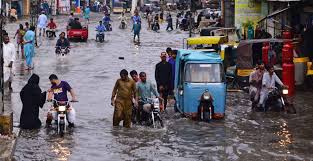ISLAMABAD (Web-Desk); In light of continuous torrential rains wreaking havoc across multiple regions of Pakistan, the National Disaster Management Authority (NDMA) has issued an urgent nationwide alert, warning of potential urban flooding, rising water levels in rivers and seasonal streams, and further rainfall-related disasters over the coming days. The authority has highlighted the critical situation developing due to monsoon activity and urged citizens, particularly in vulnerable zones, to remain cautious and adhere to official safety directives.
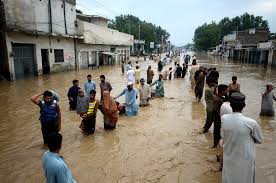
According to a spokesperson from the NDMA, the agency is coordinating closely with provincial disaster management authorities, civil administration, and the armed forces to tackle the emerging crisis. In an official advisory, the NDMA stressed that all citizens, especially those living in low-lying or flood-prone areas, must avoid crossing overflowing rivers, bridges, and submerged roads. Residents have been encouraged to shift their valuables and livestock to safer ground and prepare emergency kits containing food, water, and essential medicines sufficient for three to five days.
Capital Cities on High Alert
The twin cities of Islamabad and Rawalpindi have experienced particularly intense rainfall, with more than 240 millimeters recorded during an 18-hour spell, significantly raising the risk of urban flooding. Authorities warned that Nullah Leh—an infamous water channel known for overflowing during heavy rains—has seen its water level rise by more than 22 feet, prompting the sounding of sirens and triggering evacuation orders in nearby neighborhoods. Officials fear the surge could cause devastating flash floods in surrounding areas.
In anticipation of worsening conditions, the Water and Sanitation Agency (WASA) declared a rain emergency, mobilizing drainage teams and heavy machinery to address accumulating water in critical locations. WASA Rawalpindi’s Managing Director Saleem Ashraf confirmed that water levels reached 22 feet at Katarian and 23 feet at Gawalmandi Bridge, both crucial points for flood management.
Emergency services, including Rescue 1122, are on high alert, with their personnel assisting in relocating people to higher ground and monitoring potentially hazardous structures. Rawalpindi’s deputy commissioner announced a local holiday to reduce public movement and encourage residents to remain indoors amid flood threats.
Maryam Nawaz Declares Province-Wide Emergency
Punjab Chief Minister Maryam Nawaz Sharif confirmed that an official emergency had been declared across parts of Punjab due to “unprecedented” monsoon rains. She urged citizens to comply with official instructions and safety warnings. “Government institutions are working tirelessly to protect lives and property. We have directed local authorities to use sirens and loudspeakers to alert residents about imminent dangers,” she wrote on X (formerly Twitter).
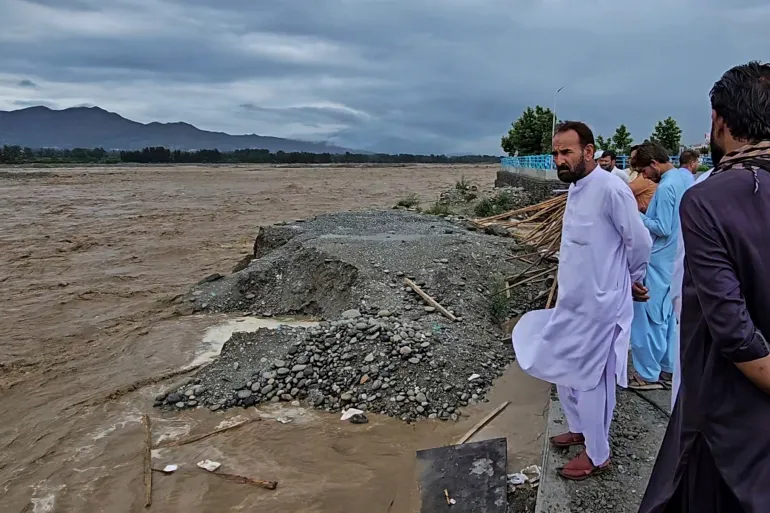
Cloudburst Devastates Chakwal
One of the most severely affected districts has been Chakwal, where a sudden and intense cloudburst resulted in a staggering 449mm of rainfall within hours, flooding homes and streets. Bilal Bin Hafeez, the Additional Deputy Commissioner, stated that civil and military teams were actively rescuing affected residents.
A similar crisis has unfolded in Jhelum, where river and canal flooding forced the district administration to call in the Pakistan Army and deploy helicopters for evacuation operations. Over 50 rescue personnel using six boats managed to save at least 57 individuals trapped in the deluge.
Sheikhupura also saw heavy rains reaching up to 217mm, causing severe waterlogging and damage to infrastructure. Secretary Emergency Services Dr. Rizwan revealed that various small dams in Chakwal had overflowed, contributing to the flooding and complicating rescue operations. Alarmingly, the famous Katas Raj Temple near Choa Saidan Shah was also inundated by floodwaters.
Humanitarian Toll Mounts
The impact of the relentless rains has been deadly. Since the beginning of the monsoon season on June 26, at least 180 people—including 70 children—have died in various rain-related incidents nationwide. In the past 24 hours alone, NDMA reported 54 deaths and over 227 injuries, with the majority occurring in Punjab. The province saw 43 deaths in one day, including 16 in Lahore, nine in Faisalabad, five in Sahiwal, and four each in Okara and Pakpattan.
Rescue 1122 data shows that more than 130 roof and wall collapses were reported across Punjab during the latest spell, and hundreds of people had to be evacuated from submerged areas. In addition to human casualties, 176 livestock were also rescued from dangerous zones.
District administrations in cities like Mianwali, DG Khan, Chakwal, Attock, and Rahim Yar Khan are working around the clock to evacuate and assist flood victims. Over 15,000 rescue personnel and 800 boats have been deployed across the province. Additionally, the Pakistan Army has begun relief operations, providing shelter, food, and medical care in areas like Jhelum’s Dhok Bhidar and Darapur.
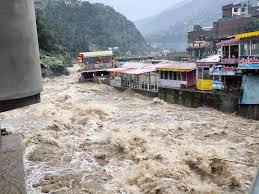
Federal Response and NDMA Visit by PM
Recognizing the scale of the crisis, Prime Minister Shehbaz Sharif is scheduled to visit the NDMA headquarters to receive a comprehensive briefing on the nationwide flood and rain situation. The NDMA reports continued rainfall in districts such as Lahore, Attock, Sargodha, Gujranwala, and Faisalabad. Meanwhile, Islamabad and Rawalpindi are expected to experience intermittent heavy showers for the next 48 hours.
The PMD’s Flood Forecasting Division has issued alerts for urban flooding in Gujranwala, Faisalabad, and Rawalpindi divisions. It warned that heavy rains may lead to a surge in reservoir levels at major dams like Tarbela, Mangla, Simly, Khanpur, and Rawal. The water level at Khanpur Dam alone rose by 4.5 feet overnight.
Situation in Balochistan and Sindh
Balochistan has not been spared either. PDMA Director General Jahanzeb Khan confirmed that 16 people have died and six others were injured in rain-related incidents. A total of 11 houses were completely destroyed and 47 partially damaged. Monsoon rains are expected to continue in the region until early September.
In Sindh, the Pakistan Meteorological Department predicts thunderstorms and rainfall in several districts. Karachi is expected to witness light rain with humid conditions, while areas such as Tharparkar, Mirpurkhas, Thatta, and Sujawal may receive heavier downpours by July 19.
Khyber Pakhtunkhwa Faces Casualties and Structural Damage
Khyber Pakhtunkhwa (KP) is facing its own set of challenges due to heavy rains. In the last 24 hours, at least six people, including four children, have died in separate incidents involving electrocution, lightning strikes, and building collapses. PDMA KP reports casualties from Bajaur, Khyber, Malakand, and Kohat, and rescue operations are ongoing. The authority warned of a heightened risk of landslides in mountainous regions like Swat, Dir, Shangla, and Kohistan.
PDMA’s Emergency Operation Centre is fully operational, and citizens have been urged to report emergencies via helpline 1700.
Islamabad and Rawalpindi’s Critical State
The federal capital continues to experience severe weather. Flash flood warnings were issued Thursday morning after water levels in Leh Nullah rose dangerously. However, by the afternoon, the level had begun to recede, dropping from 20 feet to 7 feet in some locations.
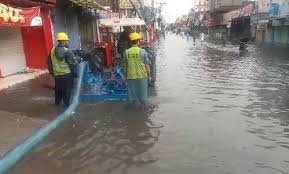
Islamabad Chief Commissioner Muhammad Ali Randhawa instructed the Capital Development Authority to remain on high alert and ensure strict monitoring of major highways and water channels. Citizens have been advised to call 16 or 1334 in case of emergency.
To support local operations, PDMA provided Rawalpindi administration with essential relief equipment, including 28 de-watering sets, 16 outboard motor boats, and 205 life jackets. Pakistan Army helicopters also rescued a stranded family from Chakri Road.
Heavy Rain Forecast Through July 17
According to the PMD, the current monsoon system affecting Pakistan is expected to last until at least July 17. The weather system, originating from Madhya Pradesh in India, is bringing strong monsoon currents and interacting with a westerly wave over Pakistan’s upper regions.
Widespread rain-windstorms with isolated heavy falls are expected across Punjab, KP, Gilgit-Baltistan, Balochistan, and parts of Sindh. The Met Office warns of flash flooding in local streams and nullahs in northern Punjab, KP, and hilly areas of AJK and GB.
There are also risks of landslides and infrastructure collapse in Murree, Galiyat, and other mountainous regions. The NDMA cautioned that torrential rainfall could damage standing crops in Punjab and KP.
Death Toll Continues to Rise
As of July 14, the NDMA confirmed that 111 people, including 53 children, had lost their lives due to monsoon-related incidents since late June. The most common cause of death was electrocution, followed by flash floods. A tragic incident earlier in the season saw 13 tourists swept away while seeking shelter on a riverbank.
With more rain on the horizon, Pakistan continues to brace for further damage and loss, even as federal and provincial authorities mobilize every available resource for rescue, relief, and recovery.
